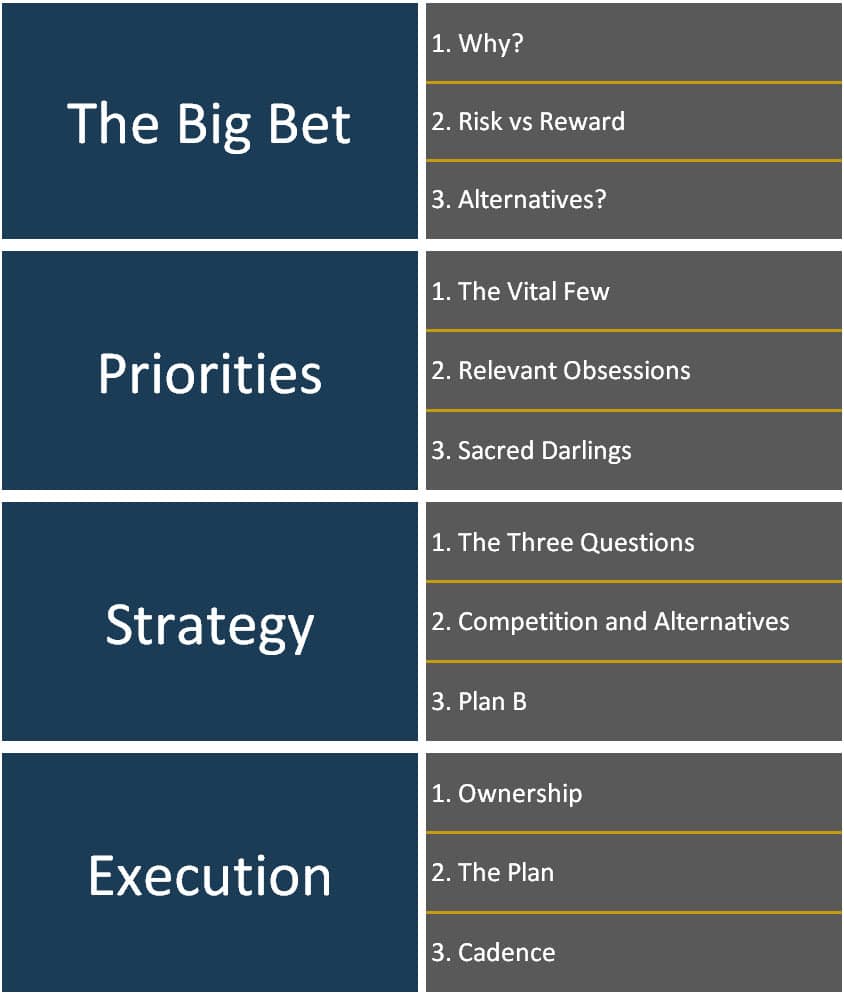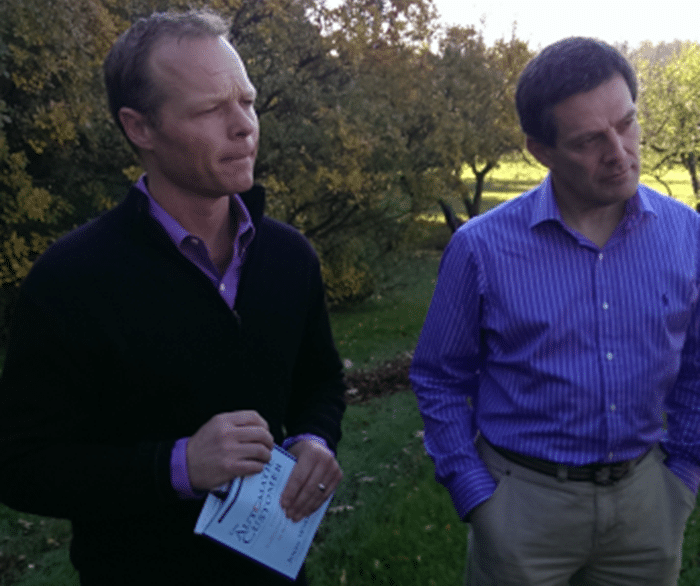What is strategy? Or, what is strategic planning? I’ll give you the sarcastic answer that I always provide – “It’s a $2 billion industry.” Harsh, or am I close to the truth? Here’s what I do know. I think we use the word strategy far too much when we really mean something else. Let me elaborate.
The Core Four of Getting Results
I almost started this section with, The Core Four of Winning Big. I fear that’s a bit too over-the-top. Results? That’s more accurate because anytime we attack our primary aim, we either get great results, poor results, or somewhere in between.
So what are the core four? Again, I’m just a small-town CFO. I don’t have a Harvard background. My opinions are from the field based on 20 years of working with small, family-owned businesses.
My core four to getting results is:
- Big Bet
- Priorities
- Strategy
- Execution
We started with the question earlier about strategy. When I hear that question, my first reaction is to push the pause button. Small business owners either going in a new direction or getting unstuck should never start with strategy first. Instead, we need to merely scratch the brain surface to find the big bet the CEO is wanting to make.
In short, what is the big bet? Why? What’s the payoff. What’s the risk vs the reward? Are there options?
I rarely see or hear about big bets in the context of strategy. But that doesn’t mean big bets are irrelevant. Think about your favorite CEOs. All of them made a big bet before they got big and succeeded. Jobs, Bezos, Walton, Ford, and many others quickly come to mind.
Does strategy come next? Maybe, maybe not.
Priorities
Again, this is opinion only. In my small-town CFO lens, priorities are next in the pecking order once the big bet has been placed.
When it comes to priorities, we’re not talking ten or more. Four at the most. Maybe three. Two are even better. The smaller the team and/or business the fewer the priorities–that’s an absolute truth.
Gary Harpst was the first person I ever heard use the term the vital few. I love that term. I even find myself using that term over priorities as I find it more personal and relatable.
When we prioritize, we are deciding. Deciding what? What we’ll do and what we won’t do.
In Latin, the root form of the word decide means to cut off. Yes, that’s hard. But remember, we have limited resources with alternative uses in small business (time, people, and money). We’ve got to get this part right to getting results, the good ones that is.
An interesting dynamic occurs once you start to get an organization required to align the resources to deliver the idea created by the very person who started it. That person can come back to become the enemy of the success because they continue creating more ideas. Instead of executing well on one, you end up being spread all over the place. This really creates a lot of disruption in the organization and reduces performance.
Gary Harpst
Strategy
Now we can talk (er, write) about strategy. Since there have been five trillion books written on this subject, I’m keeping it simple. Instead of describing strategy, how about answering a few questions first? I think you’ll find that your strategy will quickly get fleshed out.
- What is the dramatic difference of the product or service and how do you know? Yeah, that’s two questions, but both are joined at the hip. Hubris is not allowed. We need hard evidence of the dramatic difference. By the way, a tip of the cap to Doug Hall on this question. I’ve used it for years.
- What is the size of the market? I cannot emphasize this point enough. In my neck of the woods, I discount the number by about 50% when a get a number which is usually a far-too-generous-CEO opinion. Still, it’s a starting point to determining how we go forward and at what speed.
- What is the value of a customer and/or transaction once value is delivered? Hang with me as we’ll use this number to quantify our business model. But to get you started on this question, is the value of a customer $1,000 per year? More, less? Or, answer this based on a per-transaction basis.
I still have not provided a definition of strategy, but I’d still like you to answer the questions above first.
Once you do that, it’s time to get the lay of the land on the competition. Who is it? Don’t have competition (yeah, right)? Then what are the alternatives to using your product or service?
Let’s pause and take a quick break right here. Once you’ve answered the key three questions before addressing strategy, and once you gain insights about your competition, now we can start figuring how to meet our objectives. Is it hitting a certain dollar amount in sales? Is it gaining a certain market traction that you can somewhat measure? Whatever that objective is, your ‘how’ is the strategy.
Notice I’m using strategy in the singular, not plural. I believe every business has just one, big macro strategy. They have a handful of smaller micro strategies.
For example, a macro strategy might be based around being the low-cost producer, or great at providing over-the-top service, or being lightning-fast at something. That’s a singular macro strategy.
We typically find micro strategies in our business processes such as marketing, sales, operations, and customer service.
For example, a marketing micro strategy could be only using online and inbound techniques to find customers or using webinars to source B2B prospects.
I’ll even go so far and say that lean is not a macro strategy. It’s a micro strategy within operations, supply chain, and logistics. Hopefully, you get the idea – one really big strategy supported by several smaller ones.
Execution
I can’t believe I’m using this word. Next to strategy, execution could possibly be one of the most-used business terms used by CEOs and writers on strategy.
I’m too lazy to think of a better term. Plus, since I’m an occasional sports junkie (hey, I even host a popular fantasy football podcast), execution is the ‘darling’ term used by broadcasters, coaches, and even players. Accordingly, I’m sticking with the term.
Regarding execution, several questions are in order.
- Who owns the strategy that needs to be executed?
- What’s the action plan? Advice – keep it simple, nothing elaborate. If you need complicated software to roll out the plan, baby, you’re doomed.
- What’s the cadence to stay on task? That is, how often will team members meet formally and informally as this action plan is being, well, executed?
If you got this far, well done. Below is a quick summary of my thoughts from above.









